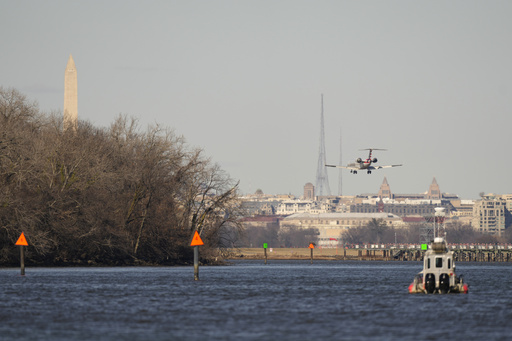ARLINGTON, Va. — Recovery teams, including divers, have been scouring the Potomac River for human remains and clearing debris following a tragic midair collision involving a passenger aircraft and an Army helicopter, which resulted in the loss of 67 lives.
On Saturday, a Coast Guard cutter equipped with a crane was stationed near the wreckage while members of the recovery team intermittently entered the water alongside smaller emergency boats.
The tragic incident, which occurred late Wednesday night, left no survivors. As of Saturday afternoon, search teams had successfully retrieved the remains of 42 individuals, with 38 of those positively identified, as per Washington emergency officials. Authorities remain optimistic about recovering all remains, although they indicated that the fuselage of the plane may need to be lifted from the water to access all bodies.
According to a statement from Washington’s Fire and EMS Department, the helicopter was momentarily stabilized by a crane on Friday night to aid in recovery efforts, although it has not yet been removed from the river.
The fatal collision took place when an American Airlines flight, which had departed from Wichita, Kansas, and was carrying 64 passengers, was preparing to land at Ronald Reagan National Airport, just across the Potomac River from Washington, D.C. The aircraft struck an Army Black Hawk helicopter that had three soldiers aboard and reportedly flew into its path.
Army officials have stated that the helicopter crew was highly trained and experienced in navigating the area’s busy airspace. Military aircraft often engage in such flights to familiarize themselves with potential routes for evacuating critical government personnel during emergencies or attacks.
The National Transportation Safety Board is anticipated to provide an update to the media later on Saturday.
Investigators are currently scrutinizing the actions of the military pilot as well as those of air traffic control. Full investigations by the NTSB typically take a year or more, although there is hope for a preliminary report within the next 30 days.
Furthermore, factors such as the helicopter’s altitude and whether the crew was utilizing night vision goggles are also under investigation, according to Defense Secretary Pete Hegseth, who spoke with Fox News Channel.
Both aircraft’s black boxes have been retrieved. Recovery efforts have seen participation from over 300 responders at any one time. Following a rainy Friday, Saturday’s clear skies and warmer temperatures provided improved conditions for the recovery team. Additionally, two Navy salvage barges were expected to assist in lifting the heavier wreckage.
This harrowing task has deeply affected those involved. “This is heartbreaking work,” stated Washington, D.C., Fire Chief John Donnelly Sr. at a press conference on Friday, acknowledging the emotional toll on responders.
On Saturday, three longtime friends visited the Potomac shoreline to find a way to honor the victims. Hailing from Maryland and Virginia, Nancy Cory, Beth Yesford, and Bonnie Gray have struggled to find peace following Wednesday’s events. Cory suggested they leave flowers in remembrance. They discovered a marina in Alexandria, Virginia, not far from the collision site, where they released flowers into the river, with the U.S. Capitol’s distinctive dome visible in the background.
“Everyone in this area has used that airport, for work, for family,” Cory remarked. “It’s just — there are no words.” Gray added, “It’s the people. We’re here to pay respects for those people.”
While the nation mourns the tragedy, another incident occurred on Friday night when an air ambulance plane crashed into a bustling intersection in Philadelphia, claiming the lives of six individuals on board — including a child who had just received treatment at a hospital — and at least one person on the ground. Officials noted that at least three people were hospitalized with injuries, and it may take days to ascertain the full extent of the fatalities and injuries caused by that crash.
Following the collision, the Federal Aviation Administration enacted strict limitations on helicopter traffic around the airport on Friday. Hours earlier, President Trump had shared a social media post asserting that the helicopter was flying at an unlawful height.
NTSB member Todd Inman indicated that investigators have interviewed at least one air traffic controller from the time of the crash, with interviews still ongoing and an unclear number of controllers present.
Additionally, the investigation will encompass staffing levels, training, hiring practices, and controllers’ records. The FAA has consistently faced challenges with air traffic controller shortages.
Officials have stated that the helicopter was supposed to maintain a maximum altitude of 200 feet (approximately 60 meters), though it remains undetermined if this limit was surpassed.
In a subsequent social media post, Trump remarked that the helicopter was “flying too high” and shared his belief that it was significantly above the required altitude.
The tragedy from Wednesday marks the deadliest aviation accident in the U.S. since November 12, 2001, when a jet crashed in a residential area of Queens, New York, shortly after takeoff from Kennedy Airport, resulting in the deaths of all 260 individuals aboard and five on the ground.
Although aviation experts often emphasize the safety of air travel, the congested airspace surrounding Reagan National Airport can pose complexities even for the most skilled pilots.




